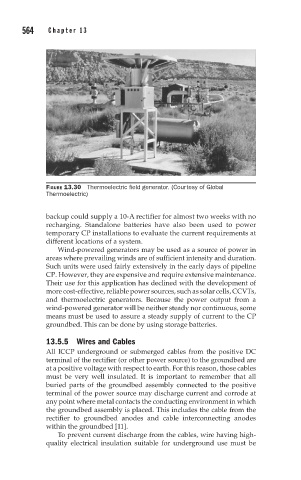Page 601 - Corrosion Engineering Principles and Practice
P. 601
564 C h a p t e r 1 3 C a t h o d i c P r o t e c t i o n 565
FIGURE 13.30 Thermoelectric field generator. (Courtesy of Global
Thermoelectric)
backup could supply a 10-A rectifier for almost two weeks with no
recharging. Standalone batteries have also been used to power
temporary CP installations to evaluate the current requirements at
different locations of a system.
Wind-powered generators may be used as a source of power in
areas where prevailing winds are of sufficient intensity and duration.
Such units were used fairly extensively in the early days of pipeline
CP. However, they are expensive and require extensive maintenance.
Their use for this application has declined with the development of
more cost-effective, reliable power sources, such as solar cells, CCVTs,
and thermoelectric generators. Because the power output from a
wind-powered generator will be neither steady nor continuous, some
means must be used to assure a steady supply of current to the CP
groundbed. This can be done by using storage batteries.
13.5.5 Wires and Cables
All ICCP underground or submerged cables from the positive DC
terminal of the rectifier (or other power source) to the groundbed are
at a positive voltage with respect to earth. For this reason, those cables
must be very well insulated. It is important to remember that all
buried parts of the groundbed assembly connected to the positive
terminal of the power source may discharge current and corrode at
any point where metal contacts the conducting environment in which
the groundbed assembly is placed. This includes the cable from the
rectifier to groundbed anodes and cable interconnecting anodes
within the groundbed [11].
To prevent current discharge from the cables, wire having high-
quality electrical insulation suitable for underground use must be

